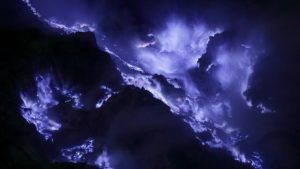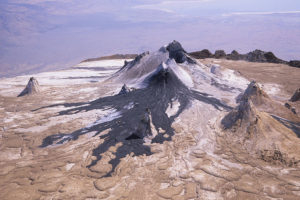
When we think about a volcanic eruption, one of the first things that come to our mind are lava fountains and flows with a characteristic bright orange and red colour. The colour of lavas can be associated with the temperature reached at the surface: dark red at low temperatures (475°C), orange at 900°C and white at extremely high temperature (>1150°C) (Kilburn, 2000).
However, some places on Earth can surprise us with unconventional colours during their activity, such as the Kawah Ijen in Indonesia and the Ol Doinyo Lengai in Tanzania.
Kawah Ijen (Indonesia) and its blue lava…or not?
Kawah Ijen volcano, in Indonesia, is mesmerising us with its (apparently) blue lava. In the last years, the photographer Olivier Grunewald documented the stunning blue flames coming from the lava flows at night.
However, I’m sorry to disappoint you, we aren’t dealing with atypical, coloured lava, but with burning blue flames, given by sulfuric gases. The lava is nothing different from the usual orange-red molten material that we usually see, but not at night when the blue flames start to be visible. What makes these flames so distinctive is the high quantity of sulfuric gases which are brought to light (and immediately burn) with the lava, reaching temperatures of 600°C.
Kawah Ijen is a stratovolcano of basalt-andesitic/andesitic composition, and currently the only active volcano of the Ijen caldera complex (East Java) (Delmelle et al., 2000). Even if the last eruption was in 1817, Kawah Ijen is still characterized by an extremely active magmatic-hydrothermal system and its crater host the largest highly acidic volcanic lake in the world, with a pH between 0 and 0.4, due to the high concentration of sulfuric acid (rich in SO4–Cl) (Caudron et al., 2015).

Kawah Ijen crater lake
And if we still want to talk about colours, sulphur itself has different shades depending on its physical state: yellow if solid,
dark red if molten, and, when burned, the flame is, indeed, blue.
Anyway, Kawah Ijen is not the only place in the world where you can find the “blue flames” phenomenon, like at the Dallol mountain, in Ethiopia, or at many (smaller) volcanic fumaroles. Also, forest fires at the Yellowstone National Park can melt and burn sulphur, creating a blue flame path.
Black and White – the Ol Doinyo Lengai (Tanzania)
The Ol Doinyio Lengai stratovolcano (Mountain of God in the Masaai language) lies in the eastern branch of the East African rift zone and is Tanzania’s most active volcano. Besides its activity, Ol Doinyo Lengai is famous for being the only active volcano in the world erupting natrocarbonatite, lava with high content of sodium and potassium carbonate minerals, nyerereite, (Na,K)2Ca(CO3)2, and gregoryite, (Na,Ca,K)2CO3 (Zaitsev and Keller, 2006).
This unusual composition makes the natrocarbonatite of the Ol Doinyo one of a kind also for being the lowest eruption temperature in the world, between 500°C-600°C.
And here comes the colour! Such a low temperature is giving a black colour in the daylight to the molten lava. However, nyerereite and gregoryite are anhydrous carbonates and they react extremely quickly with air and meteoric water. This weathering process is therefore transforming the dark natrocarbonatite into a white-grey secondary product within few hours.
Given the peculiarity and rarity of this kind of lava, the genesis of natrocarbonatite is still debated. The Ol Doinyio Lengai is considered to have mantle-derived melts, and there are two models generally accepted for their origin: the liquid immiscibility between silicate and carbonate melts (Roger, 2009) and the extrusion of a “cognate, mobile, alkaline and Co2-rich fluid condensate” (Nielsen &Veksler, 2002). However, the magmatic origin of carbonatite was confirmed by the eruption of 1960 of this volcano, and given their rarity, a lot has to be discovered yet.
So, whenever you are looking for some unconventional lavas, these two volcanoes are here to impress you!
References:
Kilburn, C. R. (2000). Lava flows and flow fields. Encyclopedia of volcanoes, 291-305.
Delmelle, P., Bernard, A., Kusakabe, M., Fischer, T. P., & Takano, B. (2000). Geochemistry of the magmatic–hydrothermal system of Kawah Ijen volcano, East Java, Indonesia. Journal of Volcanology and Geothermal research, 97(1-4), 31-53.
Caudron, C., Syahbana, D. K., Lecocq, T., Van Hinsberg, V., McCausland, W., Triantafyllou, A., … & Bernard, A. (2015). Kawah Ijen volcanic activity: a review. Bulletin of Volcanology, 77(3), 1-39.
A. N. Zaitsev; J. Keller (2006): Mineralogical and chemical transformation of Oldoinyo Lengai natrocarbonatites, Tanzania. Lithos 91 (2006) 191-207.
Simonetti, A., Bell, K., & Shrady, C. (1997). Trace-and rare-earth-element geochemistry of the June 1993 natrocarbonatite lavas, Oldoinyo Lengai (Tanzania): Implications for the origin of carbonatite magmas. Journal of Volcanology and Geothermal Research, 75(1-2), 89-106.
Roger H. Mitchell (2009): Peralkaline nephelinite–natrocarbonatite immiscibility and carbonatite assimilation at Oldoinyo Lengai, Tanzania. Contrib Mineral Petrol (2009) 158:589-598.
Nielsen, T. F., & Veksler, I. V. (2002). Is natrocarbonatite a cognate fluid condensate? Contributions to Mineralogy and Petrology, 142(4), 425-435.



Aldo
Bellissimo articolo molto chiaro
Pingback: How Hot Is Blue Lava? – Bescord
D
We are so happy to learn about this blue lava, and to look forward to learning more and more. The Earth is full of undiscovered surprises!